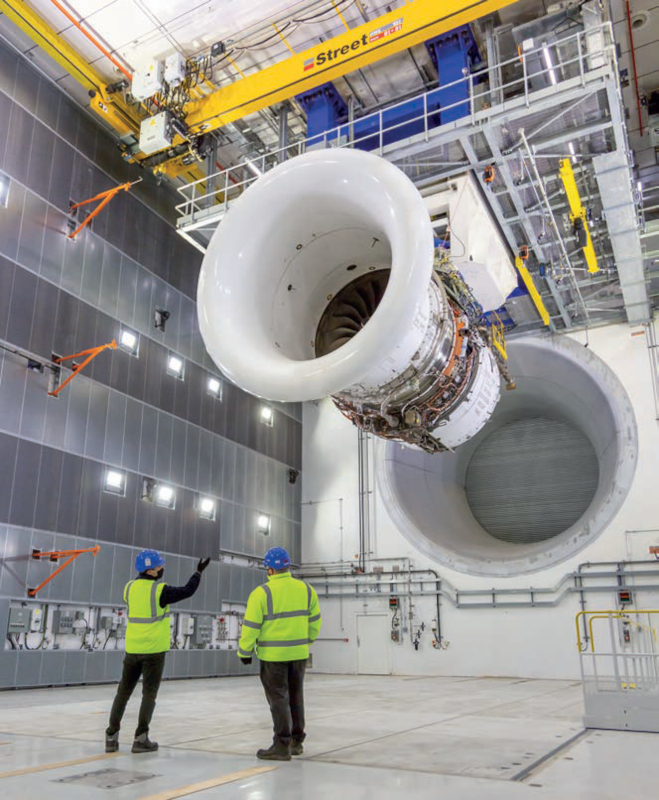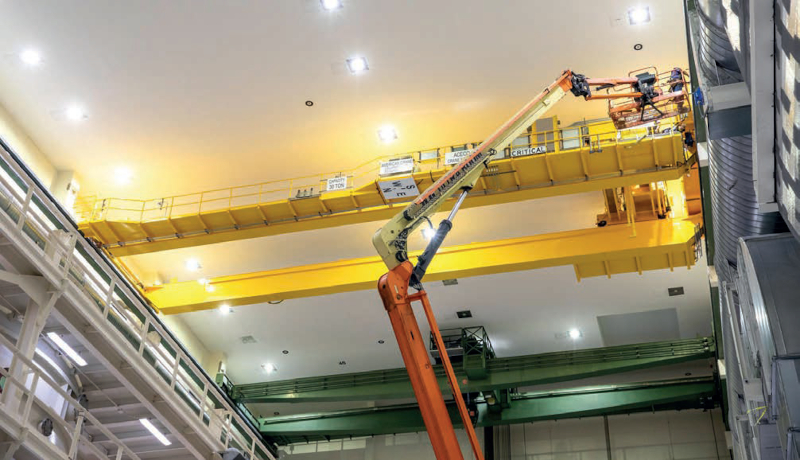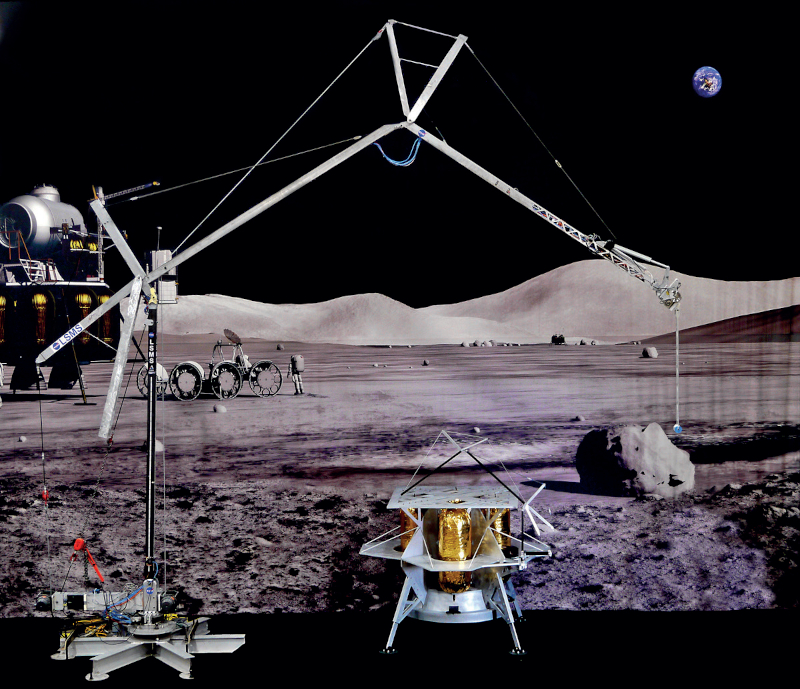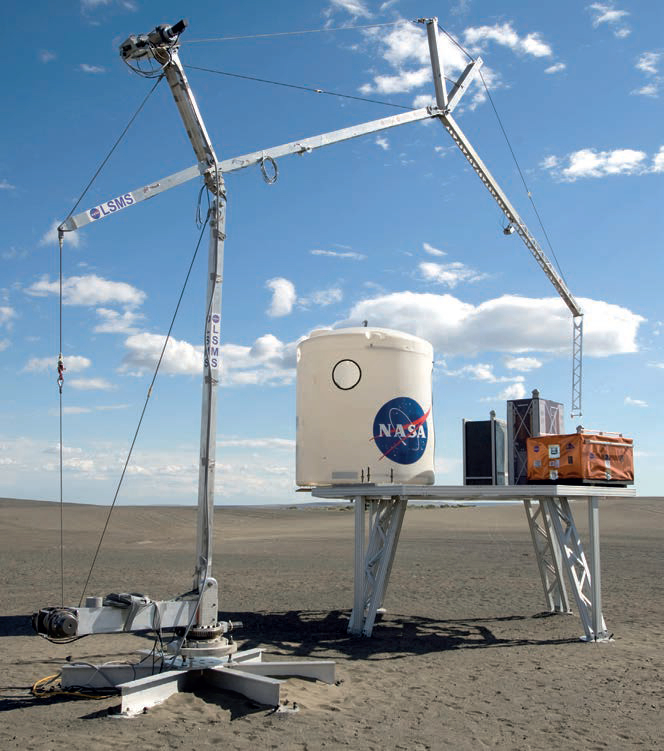To boldly lift
10 February 2022Aerospace is one of the most technically advanced sectors in the lifting industry. It requires absolute precision when handling components, and absolute assurance that the load will not fall. Julian Champkin looks at some of the solutions, on earth and beyond the atmosphere.
A crane that will work on the moon? You cannot easily get more glamorous, or higher, high-tech than that. But manned missions are planned to return there by 2025. Once they are on the moon, using astronauts in spacesuits to unload scientific equipment from their capsule, and then to manhandle it around the surface, even in one-sixth of earth’s gravity, (or, looking further, on the one-third gravity of Mars) would seem an inefficient use of that highly-trained and hugely-expensive manpower. So NASA has designed a crane to help.
Not that they call it a crane. Given NASA’s love of acronyms they actually call it a Lightweight Surface Manipulation System, or LSMS. Current devices used for in-space operations are designed to work in orbit only - that is, in zero g - and so do not have the strength to operate on planetary surfaces. (‘Lifting’ in zero gravity is a term without much meaning anyway.) Traditional cranes are specialized to the task of raising off the ground rather than the manipulator-type positioning operations that would be useful on the moon or Mars. So the LSMS is a multi-functional machine that can perform as many different tasks as possible.
The innovations incorporated into it allow it to lower payloads to the ground over a significant portion of the workspace without the use of a drum-hoist mechanism. It functions like a hybrid of crane and robot manipulator, providing a rigid connection with the payload and very precise control of it.
Minimal weight of course is essential, given the fuel-costs of transporting every kilogram of cargo into space. The LSMS uses a truss architecture with pure compression and tension members to achieve a lightweight design. Multiple spreaders arranged like spokes on a wheel allow the LSMS to maintain its high structural efficiency throughout its full range of motion. A real innovation is that rod portions of the tension members automatically lift off and re-engage the spreaders as the joint articulates, which allows a large range of motion while maintaining mechanical advantage.
It has three degrees of freedom, provided by waist, shoulder and elbow joints; and three links, - kingpost, arm and forearm, each of them 3.75 metres long. From the ground it can unload from the deck of a lander around 6m high; the first-generation design can lift 150kg on earth, 500kg on Mars, and 1000 kg on the moon. Maximum reach when configured as a horizontal boom is 7.5m.
It is self-deployable – it can set itself up on the new surface using its own actuators – and it can mount itself on a mobile rover as well as on the ground. Special purpose tools, such as a bucket, pallet forks, grappling devices, and sensor and visualization packages can be quickly added to the tip using a quick-change device at the tip end.
SARENS
Before it can get to the moon, of course, the capsule containing it has to blast off from earth, from the John F. Kennedy space station, which it will do on top of a 110-metre ‘Space Launch System Block 1’ rocket.
The moon program is called Artemis. Artemis I, an uncrewed test flight, is due to launch this year. Artemis II, a crewed mission around the moon but not landing, is scheduled for late 2023 before Artemis III lands men (and at least one woman) on the surface. To support Artemis II, in the summer of 2021 Sarens was brought in to assist in a crane replacement in the Operations Checkout Building where the Orion capsule is prepared for take-off.
The scope of their work was to remove the old 27t High Bay crane that was in place in order to install a new 30t crane which has greater lifting capacity and enhanced controls.
The crane is alongside two others, and installing it had its complexities. No headroom was available to allow a crane to perform the lifts from above, so Sarens opted for a hydraulic lift to replace the equipment from underneath. Teams were able to utilize the old crane for one final lift in order to install the new crane; they then assisted in decommissioning the older model.
Project manager Steve Gibson of Sarens said; “We were brought on by American Crane & Equipment Corporation, which we’ve been working alongside since 2008. NASA provided tremendous support and we’re certain that the Artemis II mission will have an enormous impact on future space travel.”
ERIKKILA
Meanwhile back on earth – or rather, back in the sky – Zeppelin is a name to conjure with, redolent of the huge and luxurious airships that crossed continents and oceans before heavier-than-air jet planes consigned them to oblivion. But the Zeppelin company still exists; Count Ferdinand von Zeppelin back in 1915 founded his own machining company to make the gears needed for the airships that bore his name – they needed strength and precision that could be obtained only through a patent that was new at that time. The company is now called ZF and has grown into a global giant with around 134,000 employees and an annual turnover of over 230 billion DKK.
Even though ZF no longer manufactures gears for airships it still supplies them for the aviation industry as well as for road vehicles. Its Danish subsidiary ZF Danmark has two factories, for which Erikkila recently supplied lifting equipment to speed up production. Both use solutions from crane suppliers and experts Fyns Kran Udstyr.
The workshops handle many different products, which vary significantly in weight and shape. A problem for the company was that the capacity of its earlier workstations was not being used effectively. It was solved by integrating the existing cranes with two new column-mounted cranes from Kito Erikkila. There are six workstations, and the heavy gearboxes can now easily be moved between them and handled with the nearest column-mounted crane. “We have achieved a much more efficient workflow while creating a better working environment for our employees. We are very satisfied with the solution,” says ZF Danmark service manager Thomas Aagaard.
Rolls-Royce is as famous an aviation name as Zeppelin. Its Trent turbofan jet engines power the Airbus A330, A340, A350, and A380, as well as the Boeing 777 and 787 Dreamliner. Last year Rolls-Royce successfully completed the first engine run at its new £90 million Testbed 80 in Derby, which is now the largest - and smartest - indoor aerospace testbed installation in the world. A Rolls-Royce Trent XWB jet engine was lifted into place, run, and monitored, marking a major milestone on the project which has been under construction for almost three years.
The covered testbed has an internal area of 7,500m2, making it larger than a football pitch. (The building has to be large, since it is running jet engines at full power inside.) It has been designed to test not only today’s engines but also Rolls-Royce’s UltraFan demonstrator, which is its blueprint for the next generation of ultra-efficient engines, as well as the hybrid or all-electric systems which are hoped to power flights of the future. It can accommodate engines of all sizes up to 155klbf thrust, - which would be enough to launch a Boeing 747 with just one huge engine.
Street Crane, based at nearby Chapel-en- le-Frith, installed the cranes for the Testbed 80. To lift jet engines into position they put in two 8t underslung cranes with two ZX monorail hoists on the same track. Tight space constraints and feedback to the building control system made the installation particularly challenging says Mark Hadfield, marketing manager, Sreet Crane. Because of the tight headroom in the test cell there was no room to use a traditional mobile crane, so it used a Megalift Jacking System with four giant hydraulic jacks instead.
The data systems inside Testbed 80 are more capable, and more complex, than on any existing testbed. They deliver data from more than 10,000 different parameters on an engine; an intricate web of sensors detect even the tiniest vibrations at a rate of up to 200,000 samples per second.
The testbed is also home to a powerful X-ray machine that can capture 30 images per second and beam them directly to a secure cloud where engineers around the world can analyse them. Rolls-Royce is the only engine manufacturer in the world to X-ray its engines while they are running. The walls of Testbed 80 are thick enough to contain the X-rays, which are so powerful they could otherwise X-ray a person standing six miles away.
Street Crane has been supplying the aerospace sector for over 70 years, with BAE Systems, Virgin Atlantic, and Bristow among recent customers. It has supplied cranes with single spans of more than 50 metres, multi-span cranes of more than 100 metres, and twin hoists with power slewing in unison. Secondary braking and load arrestors, overspeed protection and micro-speeds and infinitely variable speeds are standard for the sector. The complexities of aerospace engineering are immense. Cranes and hoists for them are simpler, but still have more than enough satisfying challenges.



